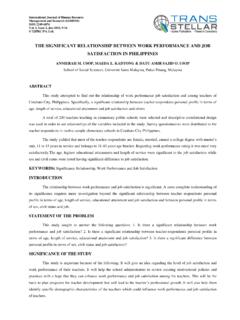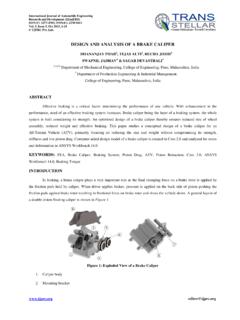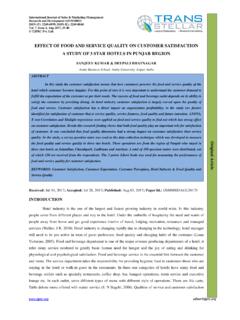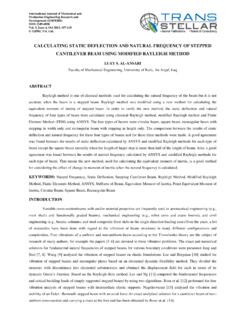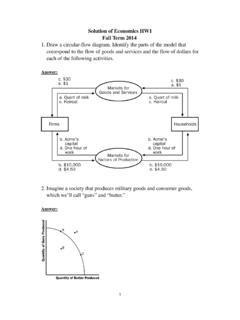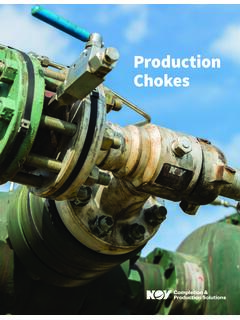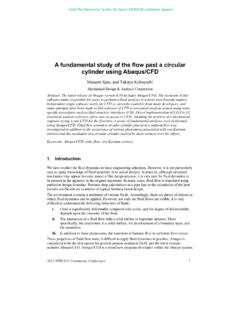Transcription of STUDY, ANALYSIS AND DESIGN OF AUTOMOBILE RADIATOR …
1 STUDY, ANALYSIS AND DESIGN OF AUTOMOBILE RADIATOR (HEAT EXCHANGER) PROPOSED WITH CAD DRAWINGS AND GEOMETRICAL MODEL OF THE FAN CHAVAN D. K1 & TASGAONKAR G. S2 Scholar, JJTU Rajasthan, Professor Mechanical Engineering MMCOE, Pune, Maharashtra, India 2 Professor Navasahyadri Group of Institutions Pune, Maharashtra, India ABSTRACT The heat exchanger, used in refrigeration unit, air conditioning unit, RADIATOR used with IC engine automobiles is either rectangular or square in shape. But the air blown/sucked by the fan is in circular area developing low velocity zones or high temperature regions are created in the corners. Different heat exchangers/radiators are studied; RADIATOR is designed, Calculations are done, CAD drawings of RADIATOR and geometrical model are developed.
2 Also power consumed by fan is studied. Experimentally it is found that the power consumed by fan is 2 to 5% of power produced by engine. It is proposed to have circular heat exchanger for refrigeration, air conditioning unit and for car radiators for maximum efficiency. Till now no significant work has been carried out on circular heat exchanger and radiators. KEYWORDS: Heat Exchanger, RADIATOR , Cad Model of RADIATOR , Geometrical Model of Fan, Power etc INTRODUCTION The proposed work relates to an improved heat exchanger ( RADIATOR ) DESIGN for either heating or cooling of a fluid. Also, it deals with the work particularly which relates to an improved fan assisted air-cooled heat exchanger used in Automobiles, Internal Combustion (IC) engines, Refrigeration system, and Power plants.
3 Different types of heat exchangers are known, in which air is used as heat transfer medium as it is freely and abundantly available, without any disposal issues. In known heat exchangers, flow of air is induced naturally or is aided by the use of one or more fans. The use of fan reduces the size and the cost of the equipment, which makes it more compact. Hence, fan assisted air cooled heat exchangers are more popular than others. In known air-cooled heat exchangers, the fan either forces or draws the air through the heat exchanger, some of which are described herein below by way of examples. In present system, the fans are placed behind the heat exchangers to force/ draw the atmospheric air.
4 These exchangers use a shroud. This directs the air over the entire area of the heat exchanger. A study was undertaken to find out the distribution of airflow and variation of its temperature [1]. Generally, all conventional heat exchangers are either square or rectangular in shape and the fans with circular blades are used to create the flow of air through them. For the present heat exchangers, there are several drawbacks or disadvantages which can be classified as follows Fans with circular blades deliver air in a circular area even when the heat exchangers are square in shape. The velocity of the air flow generated by the fan is not constant or uniform along its entire axial direction.
5 It is almost zero at the centre and gradually increases at the rate of square of the radius. International Journal of Mechanical and Production Engineering Research and Development (IJMPERD) ISSN 2249-6890 Vol. 3, Issue 2, Jun 2013, 137-146 TJPRC Pvt. Ltd. 138 Chavan D. K. & Tasgaonkar G. S When the thickness of the heat exchanger is constant, there has been no attempt to increase the heat transfer area at the periphery of such heat exchanger. The heat transfer area near the hub of the fan should be zero. Since this is not the case with present heat exchangers, they do not offer optimum utilization of material and air velocity.
6 A square or rectangular shrouds were provided for the fan to convert the circular flow of air into the required shape. Further the known equipments consume more power, more material and are therefore not cost effective [3]. Therefore it has been proposed to develop a new heat exchanger, which would avoid all the disadvantages of the known equipments [2]. POWER CONSUMED BY FAN The AUTOMOBILE RADIATOR sometimes needs additional airflow through it to prevent the engine from overheating. This usually occurs at idle and slow speed. At higher vehicle speeds, the air flows through the RADIATOR by the forward motion of vehicle provide all the cooling that is needed.
7 An engine fan or cooling fan pulls the additional air through the RADIATOR . The fan may be either a mechanical fan or an electric fan. Engines mounted longitudinally in rear- drive vehicles usually have a mechanical fan that mounts to the water pump shaft. The fan is made of sheet steel or moulded plastic. It has four to seven blades and turns with the water pump impeller. A fan shroud around the fan directs the airflow. This increases the efficiency of the fan. Transverse engines in front-drive vehicles usually have an electric fan. An electric motor turns the blades. A thermostatic switch turns on the fan only when needed. Generally, the switch turns on the fan when the coolant reaches 700 800 C.
8 It turns off the fan if the coolant drops below this temperature. On the experimental trial setup of Petrol Engine and Diesel Engine, trials are conducted in the college laboratory with fan and without fan. It is observed that power consumed by the fan is of considerable magnitude and is about 2% to 5% of total power developed by the engine [4]. Any saving in the fan power is directly the saving of precious fuel. Also BHP of the engine will be mentioned by the manufacturer or it can be calculated. Also it is observed from following examples that, Cummins engine make, 1645 BHP required 42 HP for fan of engine power. Cummins engine make, 600 BHP required 17 HP for fan of engine power.
9 COST OF RADIATORS Smaller radiators may cost less but will consume more power; hence we have to optimize the DESIGN . Cost of radiators, heat transferred per unit area by RADIATOR varies according to size, capacity and materials used for RADIATOR and fins. Standard materials generally used are aluminum, copper, steel, alloys etc. as per the cost and capacity. EXISTING RECTANGULAR / SQUARE AND OTHER RADIATOR Rectangular RADIATOR Study, ANALYSIS and DESIGN of AUTOMOBILE RADIATOR (Heat Exchanger) 139 Proposed with Cad Drawings and Geometrical Model of the Fan Figure 2: Rectangular RADIATOR This existing DESIGN is most popularly used in the current applications.
10 As shown in figure 2 hot water is allowed o flow through the inlet port, to upper tank where the hot water is distributed through a system of tubing. These tubes are surrounded and connected by a number of fins along the entire length of said tubes as shown. A fan is mounted on a shaft which causes a circulation or draught of air through the RADIATOR and the fins. A shroud is adopted to regulate the flow of air from the fan so that it minimizes the quantity of air flow to escape. The atmospheric air collects the heat from the hot water as it flows over said system of tubes. The fins provided over the tubes increases the heat transfer area. The water entering through the inlet is allowed to flow the system of tubing before it gets cooled by the air and ultimately it comes out through an outlet port, after passing through the lower tank as shown.



